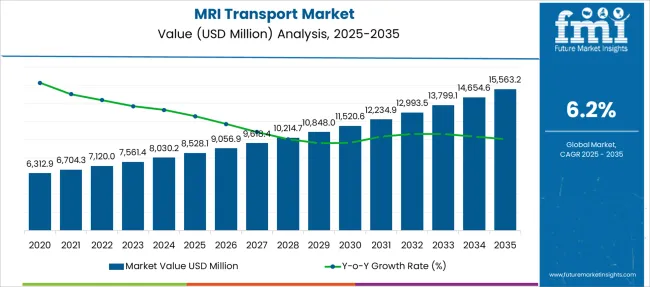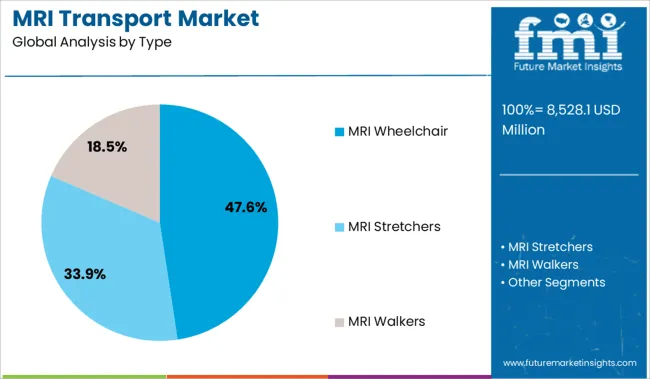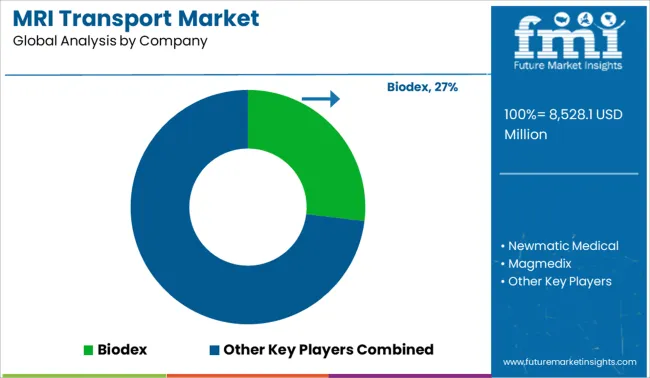The MRI Transport Market is estimated to be valued at USD 8528.1 million in 2025 and is projected to reach USD 15563.2 million by 2035, registering a compound annual growth rate (CAGR) of 6.2% over the forecast period.

| Metric | Value |
|---|---|
| MRI Transport Market Estimated Value in (2025 E) | USD 8528.1 million |
| MRI Transport Market Forecast Value in (2035 F) | USD 15563.2 million |
| Forecast CAGR (2025 to 2035) | 6.2% |
The MRI transport market is experiencing steady advancement driven by the growing number of MRI diagnostic procedures and the critical need for MRI-compatible mobility solutions. As MRI technology becomes more accessible and widely used across diagnostic centers and hospitals, the demand for non-magnetic and safe patient transport equipment has risen significantly.
Manufacturers are focusing on patient safety, ease of sanitation, and maneuverability while ensuring full compatibility with high-strength magnetic environments. Increasing healthcare investments, infrastructure modernization, and compliance with safety regulations are further supporting market expansion.
The future outlook remains strong as healthcare institutions prioritize seamless patient movement across departments without compromising imaging quality or safety, fostering ongoing demand for specialized MRI transport solutions.
The market is segmented by Type and Application and region. By Type, the market is divided into MRI Wheelchair, MRI Stretchers, and MRI Walkers. In terms of Application, the market is classified into Hospitals and Diagnostic Centers. Regionally, the market is classified into North America, Latin America, Western Europe, Eastern Europe, Balkan & Baltic Countries, Russia & Belarus, Central Asia, East Asia, South Asia & Pacific, and the Middle East & Africa.

The MRI wheelchair segment is projected to hold 47.60% of the total market share by 2025 within the type category, emerging as the leading segment. This is primarily due to its essential role in enabling the safe and comfortable movement of patients with limited mobility within MRI suites.
These wheelchairs are constructed from non-magnetic materials and designed specifically to meet the safety standards of MRI environments. Their rising adoption is supported by an increased focus on patient comfort, regulatory compliance, and the minimization of image distortion during scans.
Hospitals and diagnostic centers continue to favor MRI-compatible wheelchairs for their durability, ease of cleaning, and seamless integration with radiology workflow, contributing to their leading position within the market.

The hospitals segment is expected to account for 58.20% of total market revenue by 2025 in the application category, making it the most dominant end user. This leadership is driven by the expanding number of hospital-based imaging facilities, growing patient intake for diagnostic procedures, and the need for safe transport solutions across departments.
Hospitals prioritize MRI-compatible transport equipment to reduce risks of accidents or interference during scans, particularly in acute and emergency care settings. Moreover, institutional procurement policies, safety protocols, and staff training are increasingly aligned with the use of certified MRI transport systems.
These operational standards and infrastructure investments continue to reinforce the hospitals segment’s dominance in the MRI transport market.
The adoption of MRI transport is anticipated to grow as it is one of the most often utilized diagnostic imaging procedures in the world. It is frequently seen as crucial in the diagnosis, treatment, and management of a variety of serious disorders.
The invention of MRI transport technology is recognized as a breakthrough in medical imaging since the method is non-invasive, possibly safe, and generates comprehensive pictures of anomalies in the human body. As the number of cancer and trauma cases increases globally, so does the utilization of imaging technologies for diagnosis, propelling the market growth.
Diffusion tensor imaging with tractography, neuroimaging comprising MR spectroscopy, perfusion imaging, and functional imaging employing the bold approach are projected to drive market growth throughout the forecast period. Furthermore, the rising development of intraoperative MRI and its applications in fields such as neurosurgery is projected to drive market expansion.
One of the significant prevalent market trends is the increasing number of product releases in the high-strength category, together with the rising acceptance of these high-strength systems. Advances in technology have resulted in the invention and subsequent commercialization of high-strength imaging equipment.
Several benefits associated with greater strength equipment, such as improved imaging quality, are especially advantageous to certain types of imaging, such as vascular imaging. Superior imaging features, such as enhanced image sensitivity and improved visualization of physiological processes, are seen in higher-strength systems.
Despite the numerous benefits of an MRI system, the costs of purchasing and installing these machines are high, which has a negative influence on market growth, particularly in developing nations. A low to mid-strength MRI equipment costs more than USD 1 million on average.
Furthermore, the rising need for dwindling helium gas resources for cooling MRI equipment is raising wait times and decreasing productivity. Delayed product clearance and frequent product recall, mostly owing to a rigorous regulatory environment, are also having a significant influence on market growth.
There are several key factors which are cementing the growth of the MRI Transport markets spread across several healthcare corridors of the world. The global healthcare is developing steadily. Research and development in healthcare have changed the entire attire of the healthcare ecosystem.
Several new inventions and massive investments, startups are reshaping the entire healthcare climate of the world. Which is also promoting the development of the niche healthcare apparatus makers like the MRI Transport makers.
Market need drives the growth of an industry. Like any other market, the MRI Transport market is also dependent on the demand which comes out from different domestic and international markets. The rise in the neurological diseases around the world is acting as a major catalyst in snowballing the size of the MRI Transport market.
The MRI transport market is also driven by the compound growth of the pathology market. The market is presently growing at a CAGR of 12 percent and it is expected to touch a few billion dollars by the end of 2024. This will definitely fuel the future growth of the MRI transport market.
The major restraints in the growth of the MRI Transport market are the growth of the healthcare market which is extremely unorganised and fragmented in some parts of the world. The dominance of few countries in the MRI transport market is another prime deadlock which is pulling down the growth of the MRI Transport market.
The pricing and the export scene is completely controlled by few major healthcare tools manufacturing countries like USA, UK, Australia and New Zealand. This autonomy is barricading the organic growth of the MRI Transport market in Asia and other Middle East countries.
The leading MRI Transport makers are located in the first world countries of the world such as USA, UK, New Zealand and Australia. Though the Chinese and Indian MRI Transport market is developing fast but the market level is nowhere near to the size and quality of the markets spread in Europe and USA.

Some of the major players in the US such as Magnetica, Alstom in Australia are leading the pack. Though they are revamping their marketing strategies to tap the potential hidden in the emerging healthcare markets of India and China which are presently crowded with local MRI Transport makers.
The research report presents a comprehensive assessment of the market and contains thoughtful insights, facts, historical data, and statistically supported and industry-validated market data. It also contains projections using a suitable set of assumptions and methodologies.
The research report provides analysis and information according to market segments such as geographies, types, and applications.
The global MRI transport market is estimated to be valued at USD 8,528.1 million in 2025.
The market size for the MRI transport market is projected to reach USD 15,563.2 million by 2035.
The MRI transport market is expected to grow at a 6.2% CAGR between 2025 and 2035.
The key product types in MRI transport market are MRI wheelchair, MRI stretchers and MRI walkers.
In terms of application, hospitals segment to command 58.2% share in the MRI transport market in 2025.






Full Research Suite comprises of:
Market outlook & trends analysis
Interviews & case studies
Strategic recommendations
Vendor profiles & capabilities analysis
5-year forecasts
8 regions and 60+ country-level data splits
Market segment data splits
12 months of continuous data updates
DELIVERED AS:
PDF EXCEL ONLINE
MRI-Guided Cardiac Ablation Market Size and Share Forecast Outlook 2025 to 2035
MRI-based Quantitative Biomarkers Market Analysis - Size, Share, and Forecast Outlook 2025 to 2035
MRI Pulse Oximeters Market Size and Share Forecast Outlook 2025 to 2035
MRI Compatible Patient Monitoring Systems Market Size and Share Forecast Outlook 2025 to 2035
MRI-Safe CRT Devices Market Size and Share Forecast Outlook 2025 to 2035
MRI Guided Neurosurgical Ablation Market Insights - Demand & Growth 2025 to 2035
MRI-Compatible IV Infusion Pump Systems Market Growth – Trends & Forecast 2025-2035
MRI-Safe Neurostimulation Systems Market Growth - Trends & Forecast 2025 to 2035
MRI Safe Biopsy Needle Market
MRI Compatible Biopsy Devices Market
MRI Safe Defibrillator Market
Memristor Market Size and Share Forecast Outlook 2025 to 2035
Breast MRI Screening Market Size and Share Forecast Outlook 2025 to 2035
Portable MRI Market Analysis - Size, Share & Forecast 2025 to 2035
Preclinical MRI Equipment Market Size and Share Forecast Outlook 2025 to 2035
Magnetic Resonance Imaging (MRI) Contrast Agents Market Size and Share Forecast Outlook 2025 to 2035
Magnetic Resonance Imaging (MRI) Market Trends - Size, Share & Forecast 2025 to 2035
Transport Cases & Boxes Market Size and Share Forecast Outlook 2025 to 2035
Transportation and Security System Market Size and Share Forecast Outlook 2025 to 2035
Transport Management System Market Size and Share Forecast Outlook 2025 to 2035

Thank you!
You will receive an email from our Business Development Manager. Please be sure to check your SPAM/JUNK folder too.
Chat With
MaRIA